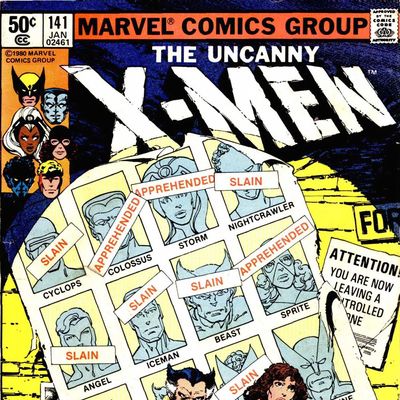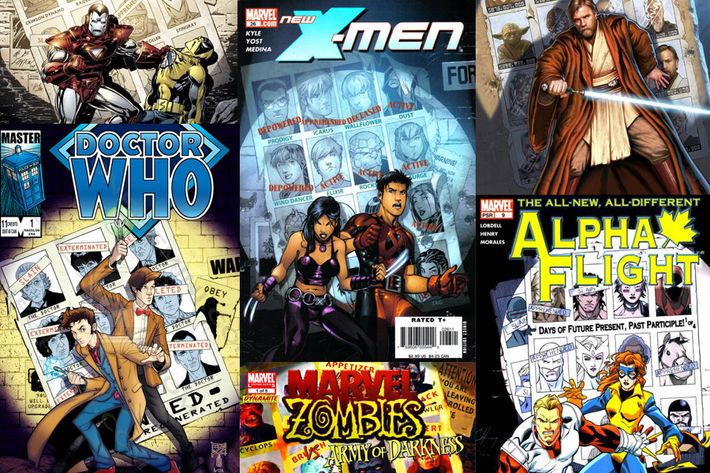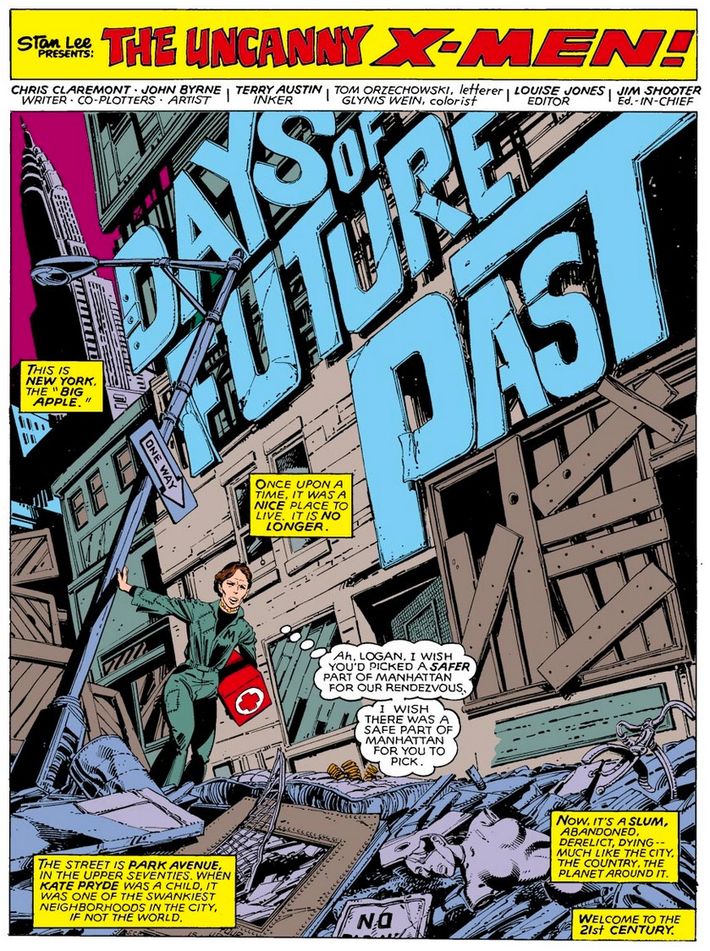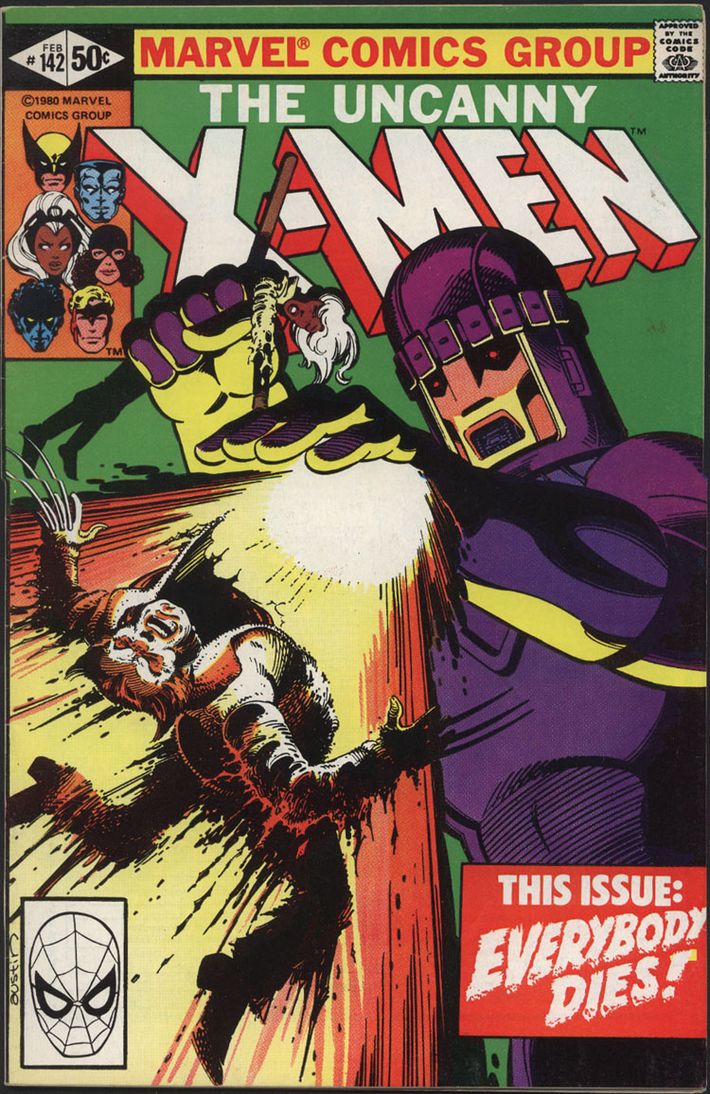
Even if 20th Century Fox’s wildest technicolor dreams come true and X-Men: Days of Future Past racks up critical acclaim and a billion dollars in worldwide gross, it’s doubtful that anyone will describe it as revolutionary. In 2014, there’s nothing groundbreaking about an action story featuring time travel, dystopian futures, and nasty robots.
But in early 1981, the pop-culture landscape was different. Over the course of just two issues of Uncanny X-Men — only 44 pages total — the original “Days of Future Past” story line changed the game and told a tale like nothing fans had seen before. Indeed, it’s probably one of the most influential comics stories ever told.
“It shook people up when they read it,” said comics historian Sean Howe, author of Marvel Comics: The Untold Story. “There was nothing to gird you, no compass to help you out.”
Comics journalist Heidi MacDonald can still recall the day she picked the first issue up from a newsstand: “I was standing there with trembling hands, looking at the cover. And then you opened it up, and you were immersed.”
MacDonald wasn’t the only one who was stunned by the cover image on the first issue of the story, Uncanny X-Men No. 141. The illustration, done by series artist John Byrne, is one of the most famous — and imitated — comics covers ever published. Wolverine and a brunette woman stand in a pile of rubble, backs to a wall, staring toward the reader. They’re trapped in some kind of searchlight. Wolverine is, for some reason, gray-haired and aged. Behind them is an enormous poster with the faces of various X-Men, obscured by red banners reading “SLAIN” or “APPREHENDED.”

Nothing had prepared fans for this grim image, or for the issue’s even-grimmer opening pages. The previous issue had been standard superhero fare: The X-Men join up with some Canadian allies and beat the crap out of a furry monster called Wendigo. The final page featured third-tier villain the Blob escaping from prison. Teaser text at the bottom had read “NEXT: DAYS OF FUTURE, PAST!” — a title as flowery as it was vague. No doubt many readers were expecting issue No. 141 to feature some kind of brawl with the Blob and his cohort, along with the series’ ubiquitous mutant angst and love triangles.
Instead, readers opened to the first page and saw X-Man Kitty Pryde walking through a bombed-out Manhattan in what looks like a prison uniform. In the previous issue, Kitty had been 13 years old, but now, she appeared to be middle-aged. “This is New York. The ’Big Apple,’” a narration box tells us. “Once upon a time, it was a nice place to live. It is no longer … Welcome to the 21st Century.”

This kind of disorienting, in media res opener had a small degree of precedent. In the 1950s and ‘60s, it wasn’t uncommon to see a first page where Batman or Superman were in a weird circumstance — turned into a human fish or something. Then the story would leap backward immediately and tell the wacky tale of how we got there.
But the beginning of “Days of Future Past” was a different beast. It wasn’t just disorienting: It was dark and didn’t let you off the hook easily. “You go into that issue without any sense of how it could possibly connect to the stories you’ve been reading in the series,” Howe said. “And then, you stay in that confused state for a while. Off the top of my head, I can’t think of any prior examples like it in serial storytelling.”
Over the next few pages, we see Kitty rendezvous with the aged Wolverine from the cover image. They talk about the U.K. preparing to nuke the U.S., and about avoiding Sentinels — mutant-killing robots that hadn’t appeared in X-Men comics for years. Kitty walks past a row of gravestones with the names of various Marvel superheroes. She reaches some kind of mutant gulag in the Bronx and meets a sad, small group of X-Men, including an apparently benevolent (and inexplicably wheelchair-bound) Magneto. One X-Man asks Kitty, “Can our mad, desperate plan work? More importantly, should it? We are toying with the basic fabric of reality.” Some previously unseen character named Rachel puts Kitty into a trance. The narration tells us Kitty’s soul is “flung out across the abyss of eternity. What happens next is anybody’s guess.” What the hell was going on?
The rest of the story gave more background on the dystopia we’d seen, but hardly made the story simple. Kitty’s consciousness is thrown into her teenage body in the present day, and she informs her confused teammates that she’s been given a mission: prevent the assassination of an anti-mutant politician and avert the subsequent Sentinel takeover. We periodically flip back to the action in the future, where the desperate band of X-Men take on the Sentinels and fail miserably. Wolverine is gruesomely burned to death, his flesh peeling off of his bones (the “YERRRRGH!” he lets out is drawn to be as large as his body). Storm is fatally stabbed in the spine by a spear. Everyone cries. In the present, Kitty stops the assassination and leaves her teen body … but the story ends on an ambiguous note.
“Does that mean we changed the future?” X-Man Warren Worthington asks.
“I do not know, Warren,” Professor Xavier replies. “Cliché though it sounds, only time will tell.”
All told, one would be hard-pressed to find a more death-filled, ambiguous, and depressing superhero tale published up to that point in comics history. Hell, even the death-of–Gwen Stacy story in Spider-Man had featured the bad guy getting his just desserts. Here, there was no lifeline of justice.
****
How did such an ambitiously grim tale come to be? The behind-the-scenes story is, in its own way, a sad one. Writer Chris Claremont and artist John Byrne had worked on the series together since 1977 and, in that time, had rocketed it to the top of the sales charts. They’d written the most acclaimed stories in X-Men history, to date. And now they were breaking up. Marvel had decided to put Byrne on Fantastic Four.
“We knew it might be the final flare of light before the star goes out, because it was our penultimate arc on the X-Men,” Claremont told me. “We both knew we were in the last stages before our separation, and this was where everything we had done as talents and as craftspeople came together.”
So they decided to go a little nuts. Just a few months prior, they’d stunned readers by killing off one of the original X-Men, Jean Grey, in the “Dark Phoenix” story line. They’d been flooded with hate mail, but sales went through the roof.
“John had an idea for upping the ante,” Claremont recalled. “From the standpoint of pure publishing practicality and mild greed, we were saying, ‘You thought we were suicidal by killing one character? Hell, now we’re gonna kill ‘em all!’”
Series editor Louise Simonson was of a similar mindset. “With ‘Dark Phoenix,’ it was the first realization that the comic-book shops had, that death sells,” she told me. “Dealers would call me and say, ‘When’s the issue where everybody dies? I wanna order a lot of that one.’”
So Simonson made a move that was as cheeky as it was shrewd: On the cover of the second issue in the story was an image of Wolverine being incinerated, and she placed text over it that simply read, “THIS ISSUE: EVERYBODY DIES!”

Byrne also knew death was a big draw, and needed villains who were up to the task. “I wanted to do Sentinels because I thought they were so cool,” he said in a 2006 interview. “But Chris said, ‘Nah, Sentinels are wimpy.’ I said, ‘No, you write them wimpy. That’s your problem. Let me plot a story with Sentinels and I’ll show you what the Sentinels can do.’ Magically, the whole plot appeared in my head.”
However, years later, Byrne realized he’d accidentally pilfered from another sci-fi tale: a 1972 Doctor Who television serial called “Day of the Daleks,” in which the metallic Daleks take over the world. “Luckily, because it was X-Men and not some guy flying around in a phone booth, there were enough differences not to get sued.”
Byrne was being modest. Although “Day of the Daleks” features a robotic dystopia, it also features a happy ending and a straightforward storytelling style, free of in media res disorientation. And while we’re on the subject of similar dystopias, this is as good a time as any to address an elephant in the room: The Terminator.
A modern reader will be struck by the similarities between James Cameron’s sci-fi landmark and Claremont and Byrne’s story: robot overlords, a desperate resistance, time travel to prevent a calamity. But Terminator wouldn’t come out until 1984. It’s doubtful that “Days of Future Past” influenced Cameron, but it’s important to remember that this kind of story — later to become commonplace — hadn’t been tried before.
Even if Cameron didn’t read “Days of Future Past,” plenty of writers, artists, comic-book editors, and filmmakers did — and its impact has echoed for more than three decades.
****
In a strictly linear sense, the story forever changed the X-Men universe. Since 1981, there have been an insane number of sequels and revisitations of the story. The aforementioned Rachel character soon traveled into the present and became a major player in the X-Men (and remains so to this day). There were spin-off events such as 1990’s “Days of Future Present,” 1996’s “Days of Future Tense,” 1997’s “Wolverine: Days of Future Past,” 2005’s “Weapon X: Days of Future Now” … the list goes on. This weekend won’t even be the first time the story has made it to the screen: it was adapted for both the 1990s X-Men cartoon and the 2000s Wolverine and the X-Men cartoon.

On a more general level, the story introduced a motif that would become, for better or worse, central to the X-Men franchise: time travel. Since then, the characters have been tossed back and forth in the timestream over and over again, creating and destroying parallel universes in story after story. “It sets up the idea of all these alternate timelines for the X-Men,” Sean Howe said. “Unfortunately, that began to make the comics almost unreadable at a point.” (Right now, the X-books feature a time-displaced X-Men team from the past and a separate one from the future.)
The story’s stylistic impact has gone beyond the X-books, of course. Most notably, it pioneered the narrative conceit of abruptly tossing a serial story’s characters into a dystopian, or at least fundamentally altered, world. In comics, that conceit appears regularly now: we’ll open an Avengers story and find our heroes destroyed by Ultron and only gradually find out what happened, we’ll see the Flash wake up in a world where he has no superpowers and there is no Superman, and so on.
But you can also find it popping up in geek TV. X-Men diehard (and onetime X-Men writer) Joss Whedon has put the idea to memorable use in at least two of his shows: There’s the episode of Buffy the Vampire Slayer where a minor character is suddenly everyone’s best friend and we’re kept confused for much of the story; and there’s the first season finale of Dollhouse, which began in an out-of-nowhere dystopian future. Lost, also written by X-Men fans, began its final season with everyone in an alternate reality, and we had to wait until the last episode to find out how the characters got there. (It also had an episode where a character travels in time by tossing his consciousness into his younger self.) Heroes even featured the time traveler Hiro talking about how “Days of Future Past” taught him everything he knows about time travel. And, of course, there’s this weekend’s $225 million movie.
But innovations mean nothing if they’re not contained in a solid story, and Heidi MacDonald attributes the tale’s staying power to craftsmanship.
“What you kids can’t imagine is that it was only two issues! Nowadays, it’d be 12,” she said. “You could read this story in one sitting. There was no fat to it. It had a drive. It was just really, really, really well done.”

